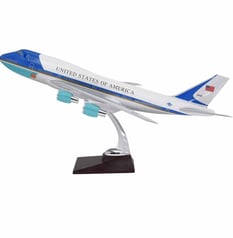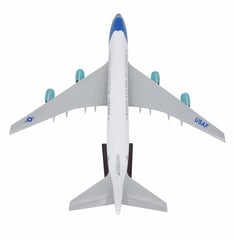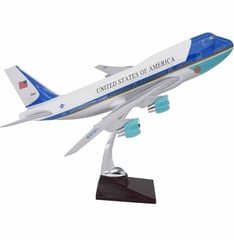Air Force One is not just an airplane; it is a powerful symbol of American presidential authority and global presence. More than a means of transportation, it represents the mobility of the Commander-in-Chief and the constant readiness of the United States government. From its humble beginnings to the high-tech flying command center it is today, Air Force One has evolved into a marvel of aviation, diplomacy, and national security.
What Is Air Force One?
Contrary to popular belief, “Air Force One” is not the name of a specific aircraft. Rather, it is the radio call sign used for any U.S. Air Force aircraft carrying the President of the United States. However, over the decades, the term has become synonymous with the specially equipped planes that are tasked with transporting the president.
Currently, the U.S. Air Force maintains two nearly identical aircraft — VC-25As, modified versions of the Boeing 747-200B — to serve this purpose.
The Origins of Presidential Air Travel
The First Flight: Roosevelt Takes to the Skies
Presidential air travel began during the Franklin D. Roosevelt administration. In 1943, amid the exigencies of World War II, Roosevelt became the first sitting president to fly while in office. He flew aboard a Boeing 314 Clipper, operated by Pan Am, to attend the Casablanca Conference.
Soon after, a dedicated military aircraft was commissioned: a Douglas VC-54C nicknamed Sacred Cow. It was specially built for Roosevelt and even included an elevator to accommodate his wheelchair.
From Sacred Cow to Air Force One
Subsequent presidents each had their own aircraft:
Harry S. Truman used the Independence, a Douglas DC-6.
Dwight D. Eisenhower used the Columbine II and Columbine III, Lockheed Constellations.
It was during the Eisenhower administration in 1953 that the designation “Air Force One” was coined, after a near collision with a commercial airline prompted the need for a unique and unmistakable call sign.
The Jet Age: Kennedy and the Boeing 707
In 1962, under President John F. Kennedy, the first jet-powered Air Force One was introduced — a Boeing 707, designated VC-137C. Designed by Raymond Loewy, it featured the now-iconic blue and white livery and the words “United States of America” emblazoned across its fuselage.
This aircraft, tail number SAM 26000, carried Kennedy to Berlin for his famous “Ich bin ein Berliner” speech and was also the plane that carried his body back to Washington, D.C., after his assassination in 1963.
The Modern Era: The Boeing 747s
VC-25A: The Current Air Force One
The two current presidential aircraft, tail numbers 28000 and 29000, are Boeing VC-25As, heavily modified Boeing 747-200Bs that entered service in 1990, during the administration of George H. W. Bush.
Key Features of the VC-25A
1. Size and Range
Length: 231 feet
Wingspan: 195 feet
Range: Approximately 7,800 miles (without refueling)
Can be refueled mid-air, allowing for virtually unlimited range
2. Onboard Amenities
4,000 square feet of floor space
A presidential suite with a bedroom, lavatory, and gym
Fully equipped medical suite with onboard doctor
Conference rooms and offices for staff and media
Two kitchens capable of serving 100 people
3. Security and Defense
Equipped with advanced communications and radar jamming systems
Shielded against electromagnetic pulses (EMP)
Flares and anti-missile defense systems
Operates as a Mobile Command Center in the event of a national emergency
Inside the Presidential Flying Office
The interior of Air Force One is designed for both comfort and function. It allows the president to perform all the duties of the office while in the air. Communication systems are hardened against cyber attacks and interference, allowing real-time connection with military and civilian agencies, including the nuclear command system.
Planned Replacement: VC-25B
The current VC-25As are over 30 years old, and plans are underway to replace them with VC-25Bs, based on the Boeing 747-8 platform. The VC-25B will include:
Improved fuel efficiency and range
Updated avionics and defense systems
Modernized interior layout
As of 2025, the program has faced delays and cost overruns. Originally budgeted at $3.9 billion, the project has exceeded $5.3 billion, and the first operational flights are expected by 2027.
Air Force One in Popular Culture
Air Force One has captured the public imagination through various films, TV shows, and books. Perhaps the most famous portrayal is in the 1997 film Air Force One, where Harrison Ford, playing the U.S. President, fights off terrorists aboard the aircraft. Though dramatized, the film reinforced the image of the aircraft as a fortress in the sky.
Trivia and Interesting Facts
1. Two Planes, One Mission: Though both VC-25As are identically configured, only one is referred to as Air Force One at a time — whichever is carrying the president.
2. Nuclear Football: The "nuclear football," the briefcase containing the launch codes, always travels on Air Force One.
3. Never Grounded: Air Force One has redundant systems for everything — engines, electronics, food storage — ensuring it is never caught unprepared.
4. Special Hangars: Air Force One is housed at Joint Base Andrews, Maryland, in a high-security hangar built specifically for the aircraft.
5. In-Air Diplomacy: Several high-level meetings and decisions, including calls to foreign leaders, have occurred aboard Air Force One.
Qatar’s $400 Million Plane Gift to Donald Trump: A Controversial Addition
The Surprise Gift
During a recent diplomatic visit to the Gulf region, reports emerged that Qatar intended to gift a Boeing 747-8 business jet to US President Donald Trump. The plan involved transferring the aircraft to the U.S. Department of Defense for use as a temporary Air Force One, with a subsequent transfer to the Donald J. Trump Presidential Library Foundation after his term. The jet's interior, designed by Cabinet Alberto Pinto, features luxurious amenities, including two bedrooms, nine bathrooms, multiple lounges, and a private office. It can accommodate up to 89 passengers.
Features of the Qatari Jet
Gold-plated interiors
Private suites and lounges
Marble bathrooms
Fully customized kitchen and bar area
Advanced entertainment systems
It was originally ordered by the Qatari royal family, specifically Sheikh Tamim bin Hamad Al Thani, but never used officially. The plane sat idle for years before being offered to Trump as a sign of goodwill, strategic friendship, or geopolitical maneuvering — depending on whom you ask.
Ethical and Legal Concerns
The proposed gift has raised several concerns:
Emoluments Clause: The U.S. Constitution prohibits federal officials from accepting gifts from foreign states without Congressional approval. Critics argue that accepting such a valuable gift could violate this clause.
National Security: The aircraft would require extensive modifications to meet the security standards of Air Force One, including secure communications and defense systems. These upgrades could cost taxpayers hundreds of millions of dollars.
Perception of Impropriety: Accepting such a gift could be seen as a conflict of interest, potentially influencing U.S. foreign policy decisions.
Air Force One: A Symbol Beyond Its Steel
For decades, Air Force One has symbolized more than presidential travel. It represents continuity of government, American technological prowess, and executive mobility in times of peace or peril. Whether soaring across oceans or serving as a skyborne White House, Air Force One remains one of the most iconic aircraft in history.
As new replacements are engineered and foreign governments like Qatar extend unexpected gestures of luxury, the mystique surrounding the aircraft — and the presidency — only grows.






